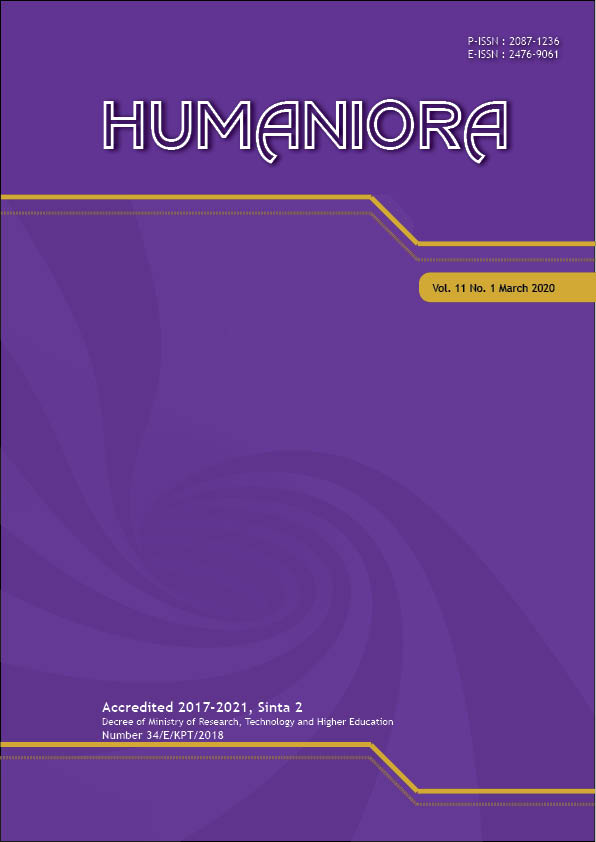Intersection Cultural Value, Nationalism, and Commodification behind the Garuda Chair as Jepara’s Signature Industries
DOI:
https://doi.org/10.21512/humaniora.v11i1.6239Keywords:
cultural value, nationalism, commodification, Garuda chair, Jepara furniture industryAbstract
The aims of the research were to identify the cultural value and nationalism behind the Garuda chair and to compare it with another style that had more sellable value as commodities. The research used a qualitative descriptive methodology using literature, observation, site visit, and interview data to be analyzed. In conclusion, the Garuda chair has a potential to become an Indonesian commodity in the furniture market and international community by promoting the cultural value behind it and the effectiveness of material using for the chair.
References
Alamsyah, A. (2018). Potret pekerja kerajinan seni ukir relief Jepara. Endogami: Jurnal Ilmiah Kajian Antropologi, 2(1), 38-51. https://doi.org/10.14710/endogami.2.1.38-51.
Gustami. (2000). Seni kerajinan mebel ukir Jepara: Kajian estetik melalui pendekatan multidisiplin. Yogyakarta: Kanisius.
Ihsan, M., & Sachari, A. (2015). ‘Catalyst Institute’ as a bridge between craftsmen and markets in Indonesian craft industry. Arts and Design Studies, 33, 44–56.
Irawati, R. H., & Purnomo, H. (2012). Pelangi di tanah Kartini. Bogor: Center for International Forestry Research.
Jamaludin, M., Firdaus, B. A. T., & Subkiman, A. (2018). The influence of Scandinavian furniture design in the development of modern rattan furniture in Indonesia. Journal of Arts and Humanities, 7(3), 19-26. https://doi.org/10.18533/journal.v7i3.1350.
Kurniawan, B. K., & Widyastuti. (2018). Jepara, ukiran, dan perubahan jaman. Productum: Jurnal Desain Produk (Pengetahuan dan Perancangan Produk), 3(3), 91–94. https://doi.org/10.24821/productum.v3i3.1771.
Larasatie, P. (2018). Indonesian furniture producers: Change makers or change takers? Society of Wood Science and Technology, 3(4), 39–50. doi: 10.22382/bpb-2018-004.
Mashdurohatun, A., & Mansyur, A. (2017). Product capabilities dynamic on industrial design carved wood in Small and Medium Enterprises (SMES) Jepara furniture in promoting the protection of intellectual property rights. International Journal of Applied Engineering Research, 12(19), 8217–8226.
Nangoy, O. M., & Sofiana, Y. (2013). Sejarah mebel ukir Jepara. Humaniora, 4(1), 257-264. https://doi.org/10.21512/humaniora.v4i1.3436.
O’Neill, M. (2017). How Scandinavian design took the world by storm. https://www.architecturaldigest.com/story/how-scandinavian-modern-design-took-the-world-by-storm.
Oriol, A. (2005). New Scandinavian design. Kempen: teNeues.
Pujianto. (1999). Sejarah dan perkembangan seni ukir Jepara. Jepara: Pemerintah kabupaten dati II Jepara. Jepara: Pemda Dati II Jepara.
Roda, J., Cad, P., & Guizol, P., Santoso, L., Fauzan, A. U. (2007). Atlas of wooden furniture industry in Jepara, Indonesia. Jakarta: Harapan Prima.
Rombe, O. S. C., Sofiana, Y., Kurniawan, B. K., & Nangoy, O. M. (2016). The Jepara chairs based on their style and period. Humaniora, 7(2), 189-199. https://doi.org/10.21512/humaniora.v7i2.3522.
Rosadi, S. (2016). Studi komodifikasi trend desain mebel kursi pada CV Jatindo Ukir Jepara tahun 2009-2014. Thesis. Yogyakarta: Institut Seni Indonesia.
Wicaksono, D., Turtiontoro., & Herawati, N. R. (2015). Peran pemerintah daerah kabupaten Jepara dalam menjaga eksistensi industri kerajinan kayu di kota ukir. Journal of Politic and Government Studies, 5(4). Retrieved from https://ejournal3.undip.ac.id/index.php/jpgs/article/view/9253/8983.
Downloads
Published
How to Cite
Issue
Section
License
Authors who publish with this journal agree to the following terms:
a. Authors retain copyright and grant the journal right of first publication with the work simultaneously licensed under a Creative Commons Attribution License - Share Alike that allows others to share the work with an acknowledgment of the work's authorship and initial publication in this journal.
b. Authors are able to enter into separate, additional contractual arrangements for the non-exclusive distribution of the journal's published version of the work (e.g., post it to an institutional repository or publish it in a book), with an acknowledgment of its initial publication in this journal.
c. Authors are permitted and encouraged to post their work online (e.g., in institutional repositories or on their website) prior to and during the submission process, as it can lead to productive exchanges, as well as earlier and greater citation of published work.
USER RIGHTS
All articles published Open Access will be immediately and permanently free for everyone to read and download. We are continuously working with our author communities to select the best choice of license options, currently being defined for this journal as follows: Creative Commons Attribution-Share Alike (CC BY-SA)




















